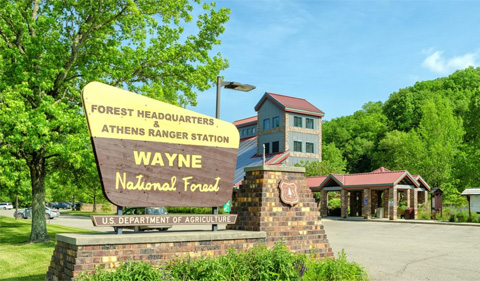
Photo Credit: Kyle Brooks
By Kyle Brooks ’17
Wildlife and Conservation Biology major
As my graduation date crept closer and closer, the stress that comes with the uncertainty of beginning a new chapter in life set in.
I had spent the last four years of my life pursuing an undergraduate degree in wildlife and conservation biology, and now it was time to find a job. I had two main pathways I could venture down. I could have chosen to continue on with my formal education and attend another university for graduate school. That wasn’t what I wanted to do though—at least at this point in time.
I wanted to venture down the field technician pathway and get my boots dirty. A few weeks before the spring semester ended, I received a call from Dr. Viorel Popescu, one of the professors in the Biological Sciences Department here at Ohio University. He said he had a job offer for me, and to stop by sometime to discuss it….
Fast forwarding to May 8, I began an internship at Wayne National Forest. Wayne National Forest is the only national forest here in Ohio, and a big chunk of it is right outside Athens. The internship position I received was just one part of a larger joint Wayne National Forest-Ohio University partnership.
Right now Wayne National Forest, along with the Athens Bicycle Club, is working on plans for a mountain bike trail system throughout sections of the national forest northwest of Chauncey. Before this mountain bike trail system can be built, the United States Forest Service (USFS) must complete an environmental impact assessment. This impact assessment helps determine if the proposed trail system will negatively impact any sensitive species or areas, and subsequently helps determine where to move the trail to if such a situation arises.
The impact assessment involves three main sections: wildlife species, plant species, and archaeological sites.
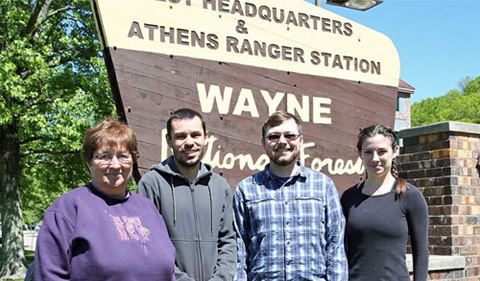
From left to right: Lynda Andrews (Wildlife Biologist at Wayne National Forest), Viorel Popescu (Conservation Ecologist at Ohio University), Kyle Brooks (myself), and Devon Cottrill (Wildlife Intern)
This is where Ohio University comes in. Professors from the Biological Sciences Department, Environmental & Plant Biology Department, and the Anthropology program chose two Ohio University students from each discipline who were interested in interning with the USFS. These student groups were to go out in the field to survey along the proposed mountain bike trail to assist with the impact assessment. Devon Cottrill and I are the wildlife interns. Every so often throughout this summer, Devon and I will be blogging about our internship at the Wayne National Forest.
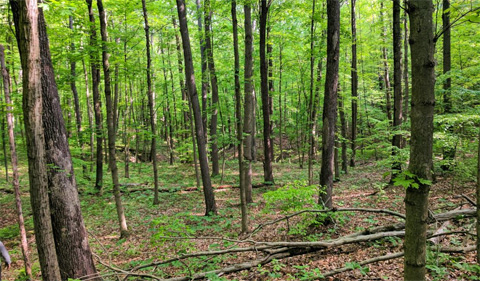
Photo Credit: Kyle Brooks
So what exactly is involved with this, at least on the wildlife side?
Right now we are assisting with the “Phase 1” trails, which is a system of 30 miles of planned trails. These trails aren’t created yet, but the routes are planned out. Volunteers with the Athens Bicycle Club recently went out and put flagging tape along the entirety of the proposed Phase 1 trails. For the first few weeks, Devon and I will be slowly surveying all of the proposed trails to map out potential habitat features—such as any fallen trees that snakes might like to bask on—that we will check at a later date, do some initial wildlife surveys, and get a general overview of the region in question.
So far it’s been a lot of fighting our way through dense greenbrier and Multiflora Rose patches, hiking up and down hills, and traveling through variously aged forests. After we hike all of the proposed trails, we will then begin targeting certain habitats to look for specific species of note.
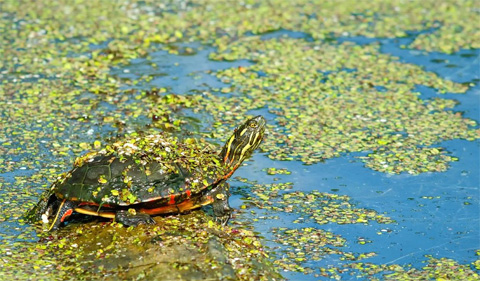
Painted Turtle. Photo Credit: Kyle Brooks
But that doesn’t mean we haven’t seen much wildlife yet! We’ve already seen a good deal of species, mostly “herps.” The term “herps” refers to all things reptilian and amphibian. We’ve seen a good deal of turtles, several snakes, and several salamanders so far. The photo above is of a Painted Turtle (Chrysemys picta). Painted Turtles are the most common aquatic turtles in Ohio, and there’s always a half dozen or so basking out in Big Bailey Wetland.
We Had Discovered a New Population
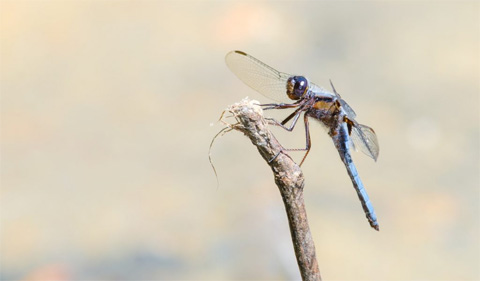
Blue Corporal. Photo Credit: Kyle Brooks
Hands down the most exciting find—so far, at least—has been the dragonfly pictured above. This is a Blue Corporal (Ladona deplanata). Although it might seem like any other dragonfly, the Blue Corporal is actually one of the 13 state-endangered dragonfly species. Last week, Devon and I stopped by Utah Pond to check things out. We saw several dragonflies zipping around, and I shot off a few photos so I could go home to identify them. While looking through those photos, I realized that the dragonflies I had shot were all Blue Corporals, which I had never seen before.
It’s super exciting to see a new species for the first time (which is called seeing a “lifer”), and it’s even more exciting when it’s an endangered species at that! And then things got even crazier; it turns out that this population had actually never been recorded. We had discovered a new population! Although other populations of Blue Corporals had been found in Athens County before, never before had they been recorded at Utah Pond, and never before had they been recorded on Wayne National Forest property within Athens County! How neat is that?
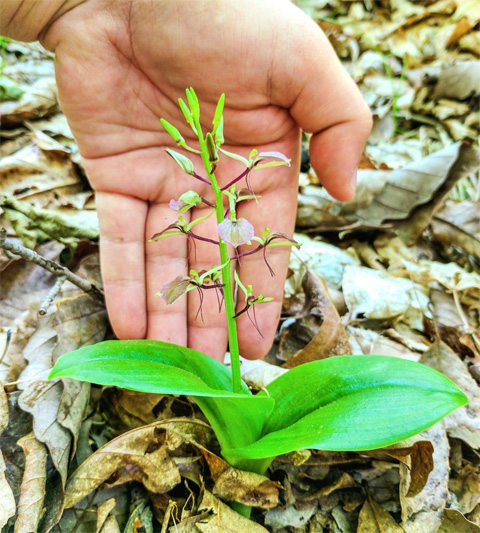
Large Twayblade. Photo Credit: Kyle Brooks
To quote the famous preservationist John Muir, “When we try to pick out anything by itself, we find it hitched to everything else in the Universe.” I might have been formally educated as a wildlife biologist, but I am first and foremost a lover of all things nature. This includes plants, which I am very fond of and interested in. When out surveying the trails, I can’t help but pay attention to some of the unique plants we come across, and I’ll be sharing a few of those here and there.
The most exciting plant I’ve found so far has been the Large Twayblade (Liparis liliifolia), a species of orchid. Although many think of orchids as a tropical group of plants, there have been 47 species of orchids recorded right here in Ohio. Most are rare and localized, but some are relatively common if you know where to look. The Large Twayblade is one of those relatively common ones; however, it’s never that abundant. It was definitely a treat to find the individual pictured above, which was nearly in peak bloom!
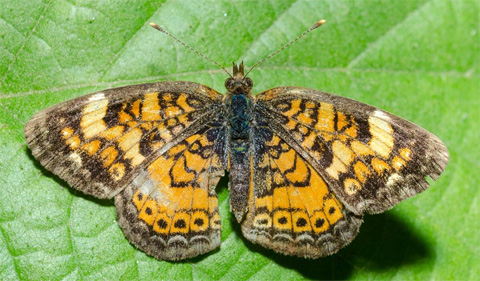
Pearl Crescent. Photo Credit: Kyle Brooks
As the weeks go by, Devon and I—along with the whole Ohio University crew—will be blogging about our time interning at Wayne National Forest along with the neat and exciting things we come across while out in the field. I hope you’ll keep up with our upcoming adventures! Thanks for reading!
– – –
Kyle Brooks is a recent graduate of Ohio University, where he received a bachelor of science degree in wildlife and conservation biology. To read more topics on Ohio nature, visit his blog.



















Comments